#tarottraditionalqabalahmagickelitarot2strikingly.com
Above all things, know thyself!
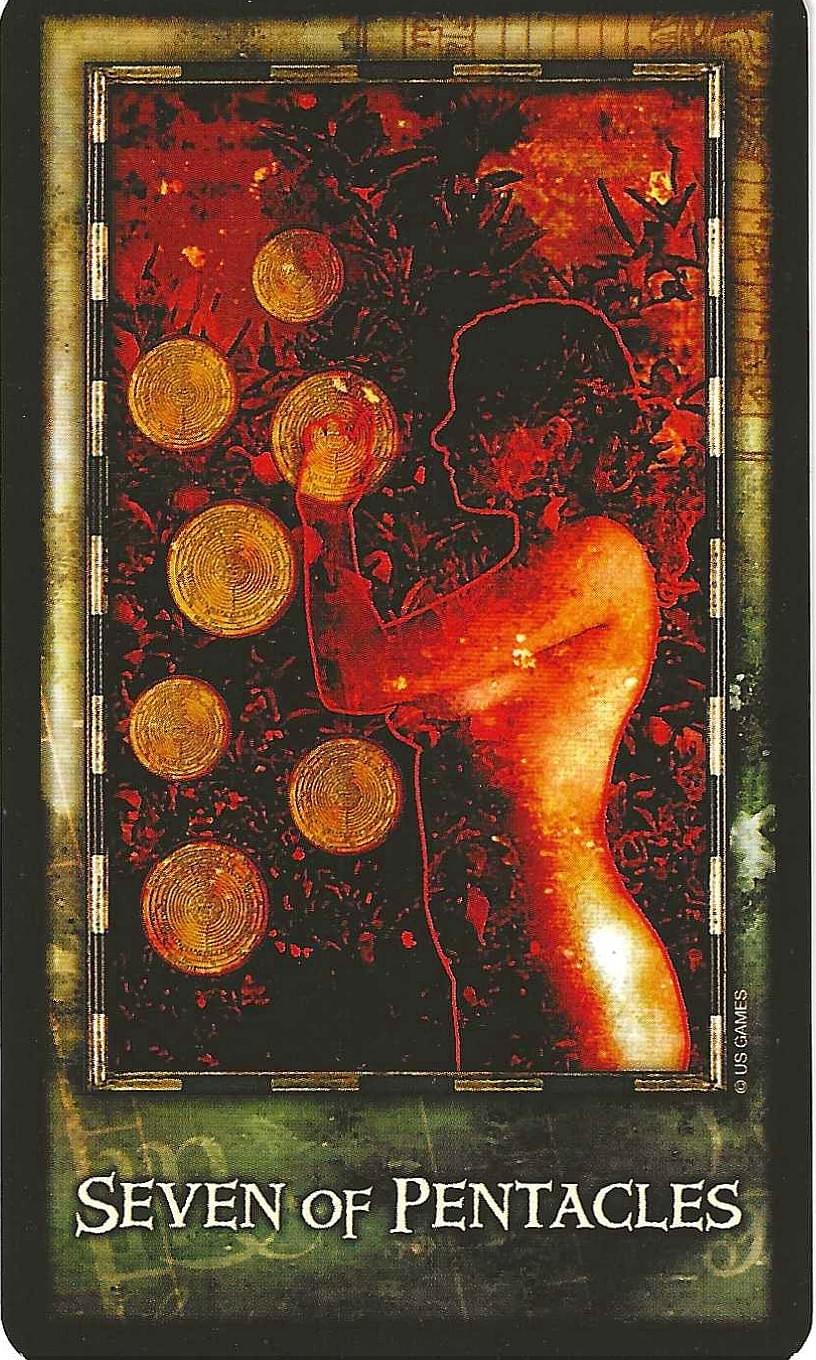
Archeon Tarot- 7 of Pentacles
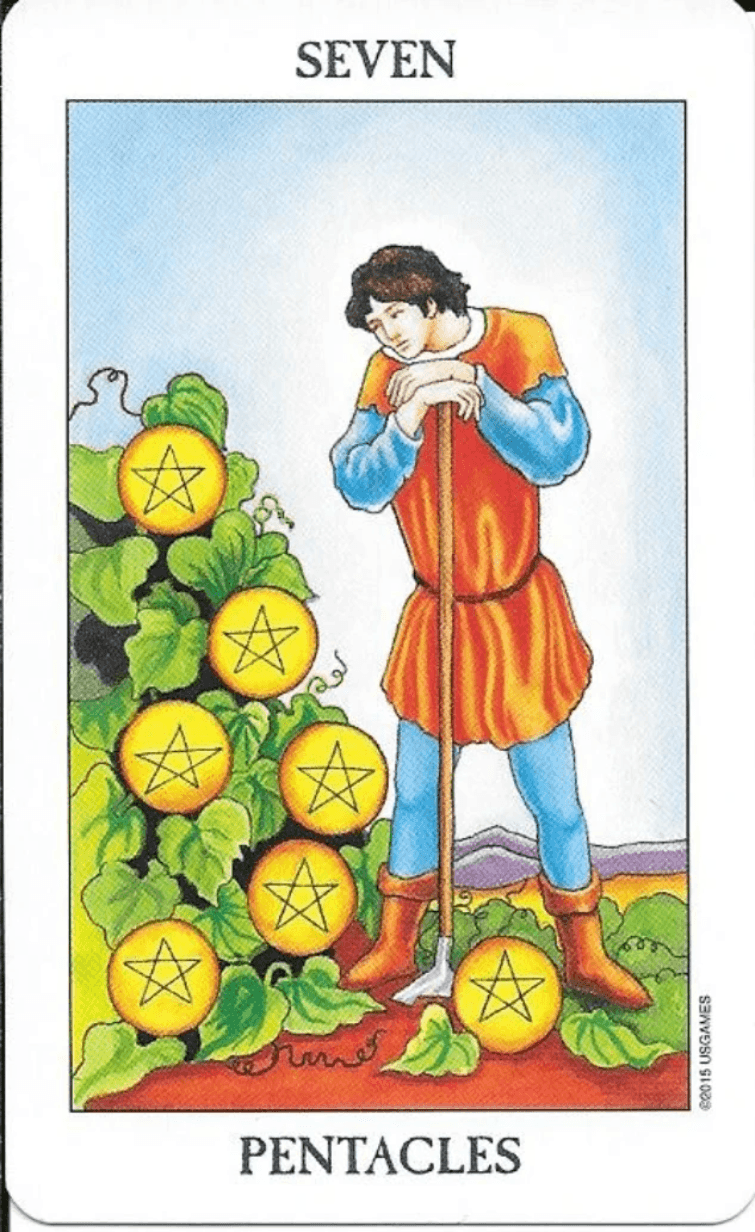
Radiant Edition: Rider-Waite-Smith Tarot- Seven of Pentacles

Tree of Life
The 7's are ruled by the 7th Sephira-Netzach which means Victory. Victory may sound pleasing, but one must remember that Victory requires a battle to be fought and won, sometimes with little reward.

Rider-Waite-Smith 7 of Pentacles
The Rider-Waite-Smith depiction presents a weary farmer leaning on his hoe, gazing at the results of his labor—a shrub bearing six pentacles, with one pentacle harvested at his feet. The gray sky suggests fatigue, monotony, and the weight of time. This image evokes not abundance, but frustration: much effort expended for meager reward. The card therefore speaks to delayed gratification, diminished returns, and the futility of repetitive struggle—a reflection of the Sisyphean myth, where labor becomes cyclical, seemingly endless, and offering little satisfaction.
Qabalistic and Hermetic Symbolism
On the Tree of Life, the Sevens are ruled by Netzach (Victory), the sphere of desire, instinct, and endurance. Yet in the earthy suit of Pentacles, Netzach’s Venusian force is stifled. Instead of blossoming into beauty or pleasure, the natural impulse toward growth becomes toil and frustration. The harmony of Venus is corrupted by material limitation, creating the experience of disappointment, scarcity, or poor fruition.
In Hermetic philosophy, the Sevens are often initiatory trials—points at which the aspirant’s resolve is tested. Here, the test comes through delayed manifestation: the material world resists, progress slows, and the seeker must confront whether their will and desire are strong enough to endure barren seasons.
Mythic Resonance
The reference to Sisyphus is apt. Sisyphus’s eternal labor mirrors the endless cycle of effort without lasting satisfaction. Yet, from a Hermetic perspective, this myth is not only about punishment—it is an allegory of the soul’s persistence within incarnation. Humanity is bound to matter, yet through persistence and conscious will, the soul learns mastery over form. The 7 of Pentacles reminds the aspirant that disappointment is not final—it is a stage of gestation. What seems barren may yet be transformed if endured with awareness.
Esoteric Teaching
Number 7: Represents initiation, challenge, and the confrontation of illusion. It is the number of Venus but also of testing, as seen in the 7 classical planets and the 7 alchemical processes.
Element of Earth: When combined with 7, the slow heaviness of matter resists Venus’s natural harmony, producing toil and discontent.
Lesson: The aspirant learns patience, persistence, and the need to re-evaluate their methods. The harvest may not match the vision, but the cycle continues, offering the chance to plant anew.
Divinatory Meaning
Upright: Hard work with little reward, fatigue, waiting, evaluation of progress, frustration, but also endurance and patience. A time of reconsidering methods and expectations.
Reversed/Shadow: Wasted effort, poor planning, impatience, loss of heart, or abandoning the work prematurely. A warning against discouragement or neglect.

Legend of Sisyphus
The legend of Sisyphus originates from ancient Greek mythology and symbolizes the human struggle against futility, repetition, and existential dread.
Sisyphus was a cunning king who repeatedly tricked the gods and cheated death itself. As punishment for his defiance, Zeus condemned him to an eternity of pushing a heavy boulder up a steep hill, only to have it roll back down each time he neared the summit.
Hermetic & Qabalistic Insights:
In Hermetic philosophy and Western Qabalah, Sisyphus' punishment reflects profound metaphysical and psychological truths. His endless task symbolizes the soul's cyclic struggle toward spiritual enlightenment. From a Hermetic standpoint, the boulder represents matter, earthly attachments, or the dense energies of Malkuth, the physical realm. The hill symbolizes the ascent along the Tree of Life toward Kether—the ultimate spiritual awakening. Each roll back to the bottom indicates the necessity for repeated purification, discipline, and mastery before true elevation can occur.
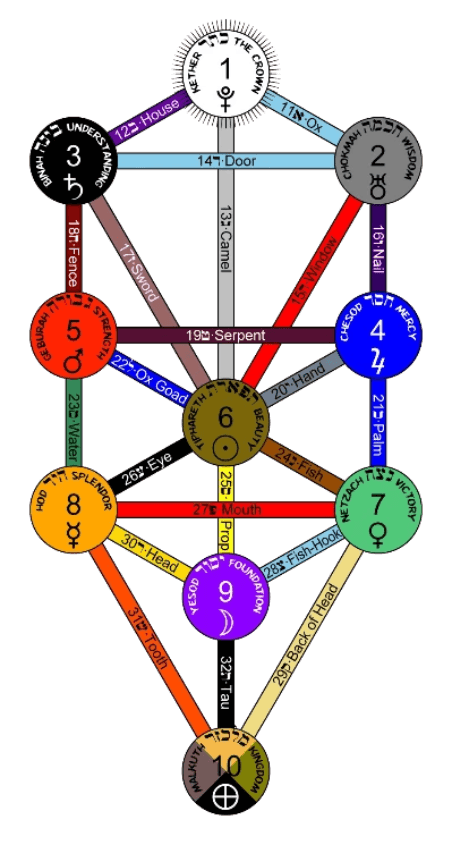
Qabalistic Pathways & Tarot:
On the Tree of Life, Sisyphus' labor can mirror the path between Hod (Mercury) and Geburah (Mars)—is also represented by the Tarot card "The Tower" (Atu XVI). This card signifies the constant destruction and rebuilding necessary for true spiritual evolution. The Tower embodies the breaking down of ego-based illusions, a task endlessly repeated until enlightenment is genuinely achieved.
Alternatively, the myth may also resonate strongly with Atu X, Fortune (Wheel of Fortune), reflecting the relentless turning of cosmic cycles, karmic repetition, and the soul's perpetual reincarnation until profound spiritual insight is attained.
Forward-Thinking View:
Rather than solely an emblem of futility, Sisyphus’ tale can offer profound empowerment to the Hermetic practitioner. It symbolizes persistent alchemical labor—the disciplined repetition required for refining the soul (the Philosopher’s Stone within) from lead into spiritual gold. Seen from a forward-thinking, initiatory perspective, Sisyphus embodies resilience and defiance in the face of cosmic absurdity, resonating with the magician’s dedication to inner mastery despite repeated setbacks. Each apparent failure becomes an incremental refinement in the alchemical Great Work.
Thus, from the Hermetic standpoint, the legend becomes less a punishment and more an invitation: a reminder that spiritual ascent demands perpetual courage, persistence, and the continuous transformation of adversity into illumination.
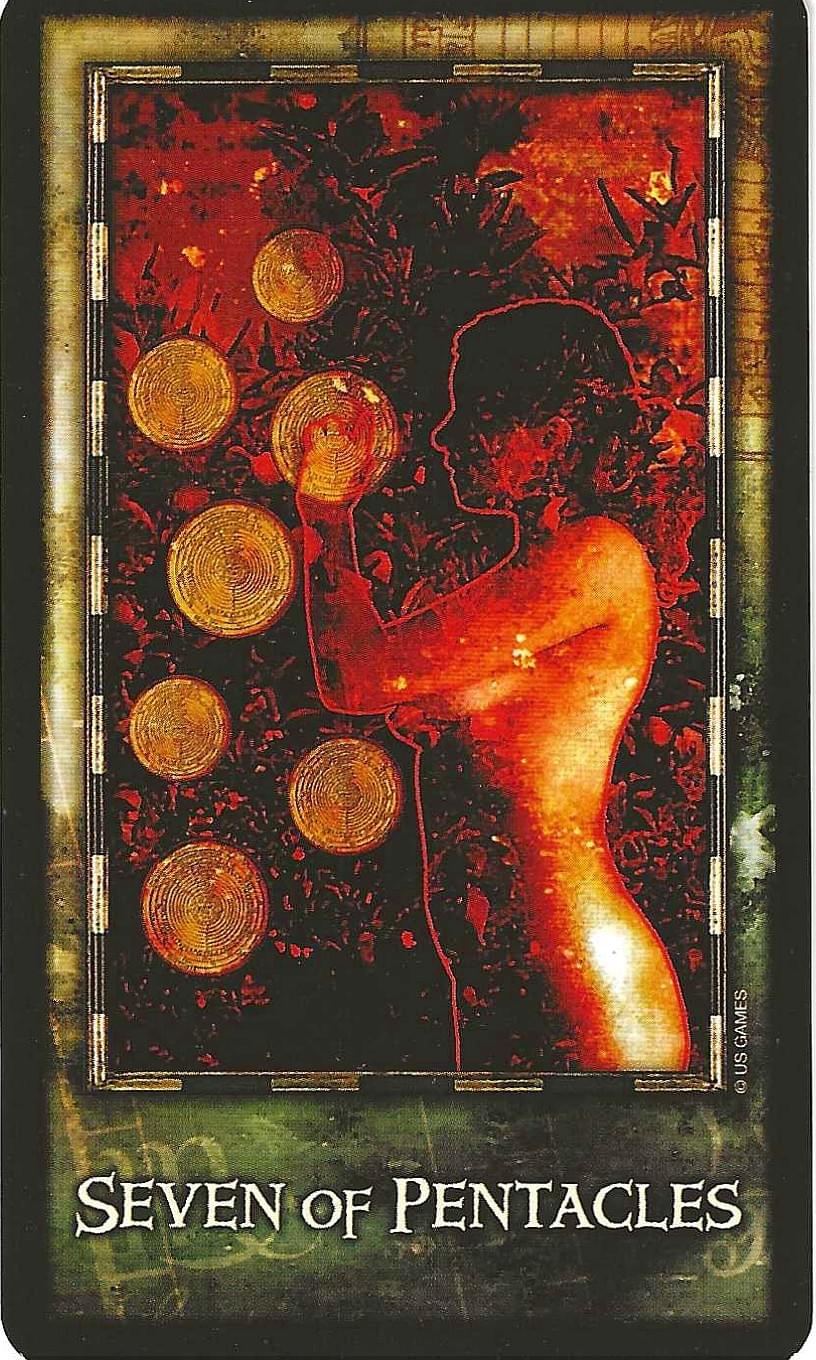
The Archeon Tarot- 7 of Pentacles
The Archeon 7 of Pentacles contrasts with the stark RWS vision. Here we see a young goddess at peace in a golden garden, contemplating a pentacle in her hand. The imagery suggests not frustration but serenity in patience. The garden thrives, yet requires tending; her role is to nurture and wait, rather than force growth. This is a softer, more hopeful image, emphasizing faith in the process of time.
Upright: Patience, planning, waiting, nurturing, and the quiet reward of watching growth unfold.
Reversed: Anxiety, melancholy, hopelessness, expectations unmet—when the vision of abundance seems to stall or wither.
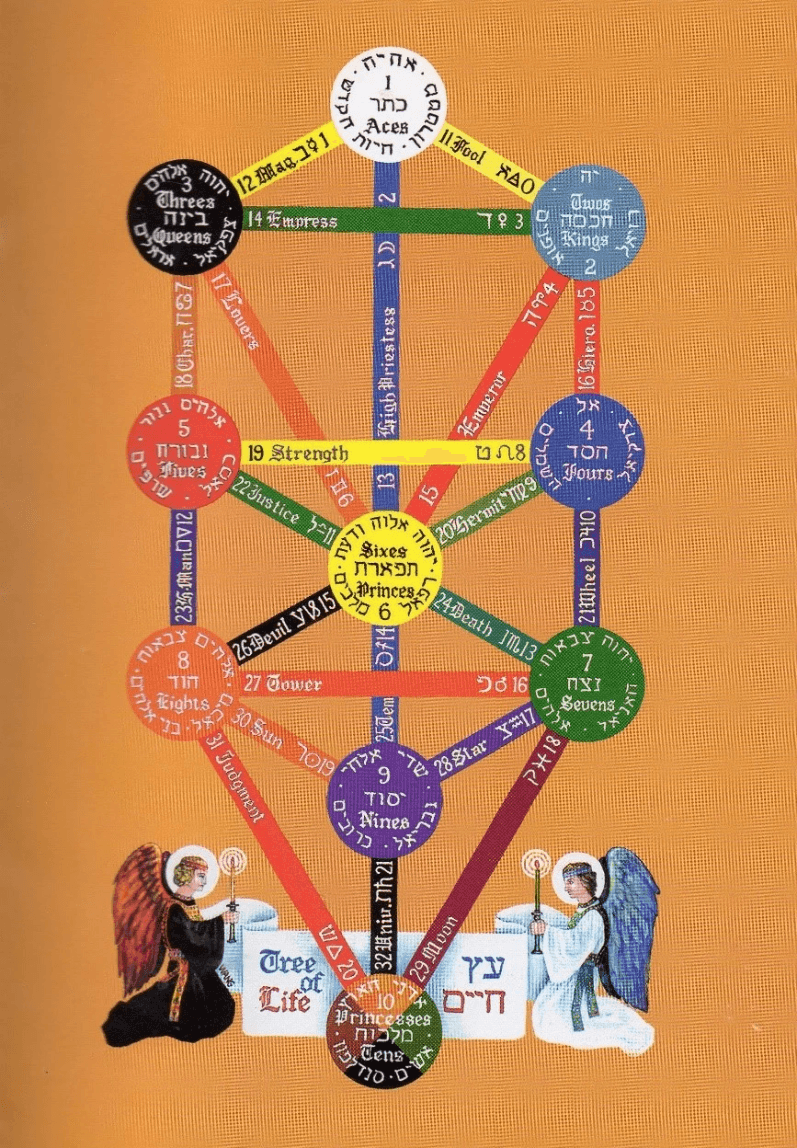
Hermetic and Qabalistic Teaching
Number 7 – Netzach (Victory): In the airy or fiery suits, Netzach can be triumphant, but in Earth it brings exhaustion, the weight of gravity on desire. Venus, the ruler of Netzach, is ill-suited to labor in dense soil. Instead of pleasure, one finds fatigue and disappointment.
Astrological Attribution – Saturn in Taurus: Saturn’s leaden influence brings delay, stagnation, or collapse of growth in Taurus, sign of fertility. Thus the “failure” motif of the Thoth deck.
Esoteric Lesson: This card teaches the aspirant that all growth requires patience, endurance, and often disappointment before renewal. Matter moves slowly. Not every effort produces immediate or visible reward, and some efforts fail altogether. Yet the true harvest is inner: wisdom, perseverance, and the pruning away of illusion.
Summary
RWS: Labor with meager returns, weariness of spirit, patience tested.
Archeon: A gentler lesson—patience, serenity, and quiet faith in the unseen growth of one’s labor.
Together, these two cards show the full spectrum of the 7 of Pentacles from the disappointment of stalled results to the peace of patience, to the existential trial of failure itself.

Astrologically the 7 of Pentacles card is Saturn in the house of Taurus. The plodding pace of the Earth bull is extra slow due to the lead weight of Saturn who is the god of myth called Cronos which is Time and whose metal is lead.
When Saturn is in the house of Taurus in an astrological chart, it influences the individual's approach to responsibilities, structure, and limitations within the realms associated with Taurus. Here are some characteristics:
Material Stability: Saturn in Taurus emphasizes the need for material stability and financial security. Individuals with this placement are likely to be disciplined and practical when it comes to managing their resources.
Slow and Steady Growth: Taurus is an earth sign known for its slow and steady approach. Saturn reinforces this trait, indicating that achievements and personal growth may come through patient and persistent efforts over time.
Conservative Values: The combination of Saturn and Taurus tends to make individuals value tradition and conservative principles. They may be cautious and reserved, preferring the familiar and proven rather than taking unnecessary risks.
Challenges in Change: Taurus is resistant to change, and Saturn's influence can amplify this quality. People with this placement may find it challenging to adapt to new situations or embrace change, preferring the comfort of the known.
Work Ethic: Saturn in Taurus indicates a strong work ethic. Individuals may approach their tasks with a methodical and pragmatic mindset, focusing on achieving tangible results.
Financial Prudence: There is a tendency to be financially conservative and prudent. Saturn's influence may lead individuals to carefully plan and manage their finances, avoiding unnecessary risks.
Potential Challenges: While the disciplined and structured approach is an asset, individuals should be mindful not to become overly rigid or resistant to change. Learning to adapt without compromising values is a key lesson for those with Saturn in Taurus.
Remember, the interpretation of Saturn in Taurus can vary based on the entire birth chart, including aspects and placements of other planets. It's advisable to consider the broader context for a more comprehensive analysis.

The number 7 holds profound symbolic significance within both Gematria (Hebrew/Qabalistic numerical symbolism) and classical Numerology. Let's explore these together through a Western Hermetic lens:
Gematria & Qabalah Insights
In Hermetic Qabalah, 7 relates directly to several significant themes and correspondences:
Sephirah Netzach:
Netzach (נצח), the seventh Sephirah on the Tree of Life, means "Victory."
Ruled by Venus, Netzach symbolizes beauty, love, harmony, emotional depth, artistic expression, and the intuitive aspect of consciousness.
Netzach embodies creative inspiration and the passion that drives spiritual ascent, connecting human emotions to divine aspiration.
Tarot Connection (Thoth Tarot):
Associated with the Tarot’s "Seven" cards, particularly embodying tests, struggles, spiritual trials, and overcoming difficulties.
Examples from the Thoth Tarot:
7 of Wands (Valour): Mars in Leo, signifying courage and determination in spiritual struggle.
7 of Cups (Debauch): Venus in Scorpio, representing illusions, temptations, and the need to overcome emotional and astral excesses.
7 of Swords (Futility): Moon in Aquarius, signifying intellectual confusion or indecision, urging clarity and discipline.
7 of Disks (Failure): Saturn in Taurus, indicating patience and endurance through apparent stagnation—understanding cycles and timing.
Hebrew Letter Zayin (ז):
Zayin, the seventh Hebrew letter, means "sword," symbolizing discernment, intellectual sharpness, and the power of the intellect to separate illusion from reality.
Gematria value: 7, highlighting spiritual insight, self-reflection, analytical contemplation, and the necessity of intellectual balance.
Numerological Insights (Classical):
In classical Numerology, 7 is the quintessential mystical number:
Associated with introspection, spiritual awareness, and philosophical thought.
Represents seekers of deeper truths, hermits, and mystics who transcend mundane interests to pursue metaphysical wisdom.
Connected to esoteric knowledge, intuition, psychic sensitivity, and heightened perceptive faculties.
Often indicates solitary reflection, contemplation, and a quest for profound inner truth and higher meaning.
Integration of Hermetic and Numerological Themes:
Both systems agree that 7 symbolizes the pursuit of wisdom through introspection and the necessity of a quiet, contemplative mind for spiritual advancement.
Alchemically, 7 represents the stages of transformation in spiritual alchemy (such as the seven classical planets and metals)—illustrating an inward journey toward perfection, self-realization, and illumination.
Forward-Thinking Hermetic View:
Viewed from a contemporary Hermetic perspective, 7 is also associated with the process of integrating intuitive wisdom with rational understanding—essential for achieving balance in a rapidly changing, interconnected world. It urges the practitioner toward clarity, discernment, and inner stability amidst outer chaos.
In today's context, embracing the number 7 invites one to cultivate quiet spaces within, creating a bridge between analytical reason and intuitive knowing. This harmonization paves the way for genuine spiritual growth and effective magickal workings in alignment with cosmic principles.
Thus, the number 7 serves as a beacon guiding the modern magician toward deeper insights and balanced mastery on both intellectual and intuitive levels.

The Archeon Tarot 7 of Pentacles, interestingly assigns a naked goddess tending her garden. This comes from the concept of the Seven Hathors which is deeply embedded in Ancient Egyptian cosmology and metaphysics, often interwoven with celestial associations, notably the star system Orion and Sirius. Let’s explore this connection from a Hermetic and forward-thinking Qabalistic perspective.
Who are the Seven Hathors?
The Seven Hathors were a prominent collective of goddess figures in Ancient Egyptian religion. Hathor herself was an Egyptian goddess embodying motherhood, joy, love, fertility, music, beauty, dance, sexuality, and celestial illumination.
The group of Seven Hathors served as divine guardians of destiny, fate, and childbirth. They were often depicted as celestial midwives who announced the fate and destiny of newborns at their birth, determining both their earthly and spiritual destinies.
Connection to Orion & Sirius in Ancient Egyptian Cosmology:
Ancient Egyptians held Orion (representing Osiris, the divine initiatory force) and Sirius (representing Isis-Hathor, the feminine cosmic source of life and renewal) in reverence, often portraying these stars as divine origin points:
Orion was the cosmic home of Osiris, the resurrected god-king, embodying spiritual rebirth and resurrection.
Sirius, the brightest star, was associated with Isis-Hathor, symbolizing spiritual illumination, nurturing cosmic energies, and initiatory feminine wisdom.
The Egyptians considered Orion and Sirius as celestial homes of divine beings ("gods" and "goddesses") who initiated humanity into wisdom and spirituality.
Hermetic & Qabalistic Interpretation:
From a Hermetic-Qabalistic viewpoint, the Seven Hathors correspond beautifully to symbolic and archetypal principles:
1. Sephirothic Reflection (Qabalah):
Seven Hathors as Netzachian Forces:
Netzach (the 7th Sephirah, Venusian in nature) perfectly corresponds to Hathor’s attributes of love, beauty, joy, and destiny. The Seven Hathors, as collective feminine forces, embody the multifaceted Venusian principles—harmonizing destiny, intuition, creativity, and emotional balance.
2. Initiation and Destiny:
Celestial Midwives & Cosmic Birth:
The Seven Hathors determine fate at birth, analogous to how Hermetic magicians perceive planetary forces influencing the soul's incarnation and karmic destiny. They represent astral mediators guiding the soul’s initiation journey from celestial realms into manifestation.Gatekeepers & Guardians:
Like Hermetic planetary spirits or angelic intelligences, the Hathors represent guardians at spiritual thresholds, guiding initiates toward rebirth (Osirian mysteries) and facilitating soul transformations.
Forward-Thinking Hermetic Insight:
In modern Hermetic practice, the Seven Hathors can symbolically serve as archetypal guides aiding spiritual rebirth and soul evolution:
Integrative Feminine Wisdom:
Representing the awakening of higher intuition, empathy, creativity, and emotional intelligence needed to balance contemporary spiritual evolution.Cosmic Consciousness & Higher Destiny:
Invoking their archetypal energy can help modern magicians attune to cosmic patterns and spiritual destinies, integrating divine feminine wisdom into practical manifestation and ascension work.Stellar Alignment & Initiation:
Practitioners might align rituals, meditations, or invocations with the star systems Orion and Sirius to integrate stellar initiatory energies, mirroring ancient Egyptian practices.
Practical Qabalistic Application:
In a practical Qabalistic-Hermetic working, one could:
Use Thoth Tarot’s "The Star" (Atu XVII, Aquarius, linked symbolically to Sirius-Orion stellar consciousness) to meditate upon the celestial influence of the Seven Hathors, facilitating visionary insight.
Utilize Netzachian energies (green candles, rose incense, copper talismans) to invoke Hathor’s joyful, harmonious, and intuitive powers for spiritual destiny-work and creative manifestation.
Perform pathworkings or guided meditations visualizing the Seven Hathors as guides imparting knowledge about the soul’s cosmic origins and spiritual potentials.
Conclusion:
Thus, while the Egyptians themselves did not literally state "the gods came from Orion," their mythology explicitly tied Orion and Sirius to profound divine beings—such as Osiris, Isis, and the Hathors—representing the celestial origins of wisdom, consciousness, and initiatory spiritual power. The Seven Hathors, therefore, are powerful symbolic intermediaries guiding souls along their destined paths, embodying the sacred celestial harmony between humanity and the cosmos.

When the 7 of Pentacles is thrown during a reading, implied:
- Is a fear of failure with finances, health, and relationships. However, 7 in Netzach is a weak event, and deregulation of the element of earth, so soon the querent's project will be completed if determined to "keep on" and ignoring the feelings of never finishing the task.
- The Determination to release this fear of failure should go on for 7 weeks or 7 months. However, this determination must be hard fought, for there is a tendency to abandon labor, and allow everything to sink in a mire of sloth.
- Yet again, putrefaction is before the transformation of purification, so this is the point where the "lowest fallen becomes the highest exalted".
- Is that you shall succeed if you don't listen to the thoughts of failure that are tempting your brain. Push harder, you'll soon succeed!
If ill defined by surrounding cards, it implies:
- Deep-rooted blockages.
- Anxiety about money.
- Impatience.
Thank you for your interest, comments, and supportive donations. May you live long and prosper!
Thoth Master Class: Western Hermetic Qabalah & Tarot
One-on-One Esoteric Training with Magus Eli
Awaken Your Resonance with the Thoth Tarot
This is not an ordinary Tarot class. The Thoth Master Class is a personalized journey into Hermetic Qabalah and the mysteries of the Thoth Tarot, guided one-on-one by Magus Eli.
These sessions are designed to align your soul’s archetypes with the Tree of Life, blending mystical philosophy with hands-on Tarot practice for profound spiritual transformation.
What Makes This Class Unique?
Private Instruction: Just you and the Magus in a 2-hour Google Meet session — fully tailored to your goals.
Flexible Scheduling: Weekly, every two weeks, or monthly (12 sessions recommended for full mastery).
Recorded Lessons: Every session is recorded for your personal review and ongoing study.
Hermetic Depth: Learn Tarot as a gateway to the Tree of Life, elemental forces, and pathworking.
Practical Mastery: Practice Tarot layouts live with guided interpretation to build confidence and resonance.
What You’ll Learn
The structure of the Thoth Tarot: Major Arcana, Minor Arcana, and Court Cards
The Western Hermetic Qabalah: Ten Sephiroth, Four Worlds, and 22 Paths
Pathworking and meditative techniques using Tarot as a key to inner temples
Hermetic spreads and ritual applications for personal transformation
Developing personal gnosis and building your own mystical framework
Required Materials
The Qabalistic Tarot: A Textbook of Mystical Philosophy by Robert Wang
Thoth Tarot deck (Crowley/Harris edition preferred)
Personal journal or Book of Shadows
Is This Class for You?
No prior Tarot experience is required — beginners and advanced seekers are welcome.
Perfect for anyone drawn to Hermetic wisdom, deep archetypal work, and personal gnosis.
How to Enroll
Email eli@elitarotstrickingly.com to request availability and begin your personalized resonance mapping session.
Call to Action
Awaken the archetypes within. Enter the living mysteries of the Thoth Tarot. Begin your Master Class today. For Aspirants who budget is tight, I also provide a sliding price scale.
3 Western Hermetic Magick Websites Helping people become more magic and less tragic since 2010.
Traditional Tarot Card Comparisons, tarot store and blogs.
Home page, Tarot Store, Master Thoth Tarot Class page and nontraditional Tarot Card Blog.
Western Hermetic Magick invocation and ritual website and Magick blogs.

